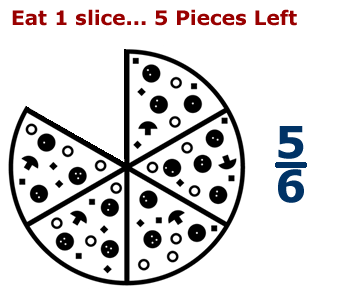Le frazioni e operazioni matematiche

Le frazioni si leggono usando il numero cardinale per il numeratore e il numero ordinale per il denominatore. Quando il numeratore è maggiore di 1 il denominatore deve essere volto al plurale.
Questa regola è valida per tutte le cifre tranne per il numero 2, che viene letto "half" al denominatore e "halves" al plurale.
Per esempio:
1/2 | a half | one half [tooltip]un mezzo[/tooltip]
1/3 | a third | one third [tooltip]un terzo[/tooltip]
1/4 | a quarter | one quarter [tooltip]un quarto[/tooltip]
2/3 | two thirds [tooltip]due-terzi[/tooltip]
3/4 | three quarters [tooltip]tre-quarti[/tooltip]
Ricorda !
Two and a half [tooltip]due e mezzo[/tooltip]
Half a kilo [tooltip]mezzo kilo[/tooltip]
Five and a half [tooltip]cinque e mezzo[/tooltip]
Five and a half hours [tooltip]cinque ore e mezza[/tooltip]
Quante fette di pizza hai mangiato?

Come si legge un'operazione matematica?
[7 x 5 + 1] : 6 = 29-1/2 [ seven times five plus one - all divided by six equals twenty-nine and a half ] [tooltip]sette per cinque più uno tutto diviso sei è uguale a ventinove e mezzo[/tooltip]
x ( per la moltiplicazione "per" si traduce ) "times"
/ ( per la divisione "diviso" si traduce ) "divided by"
+ ( per l'addizione "più" si traduce ) "plus"
- ( per la sottrazione "meno" si traduce ) "minus"
= ( per indicare "uguale" si traduce ) "equals"
--- PER APPROFONDIRE L’ARGOMENTO ---
Pronunciation of Large Fractions: basically, there are three ways to pronounce a fraction. Let's take 2/3 as an example. We say it as: two-thirds, two over three, and two divided by three. "Over" is used in a more casual manner or for larger and complex numbers.